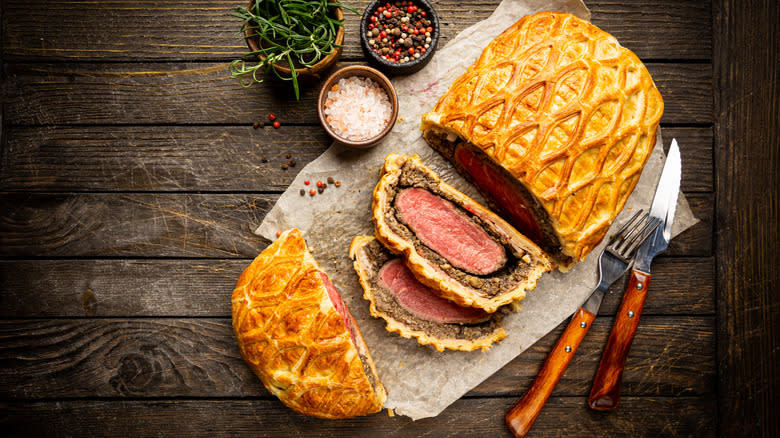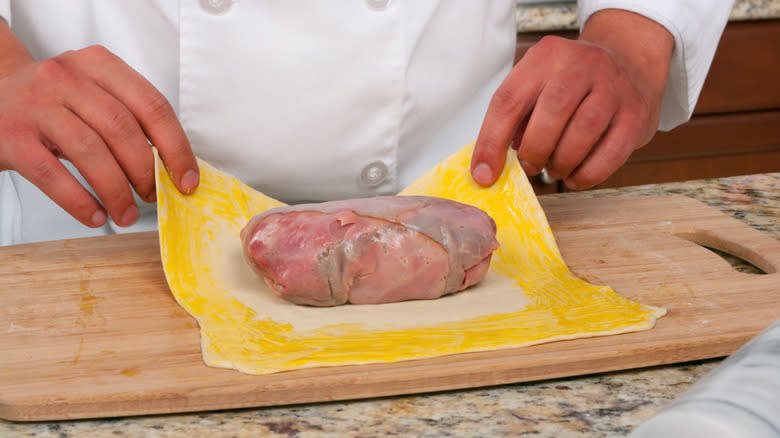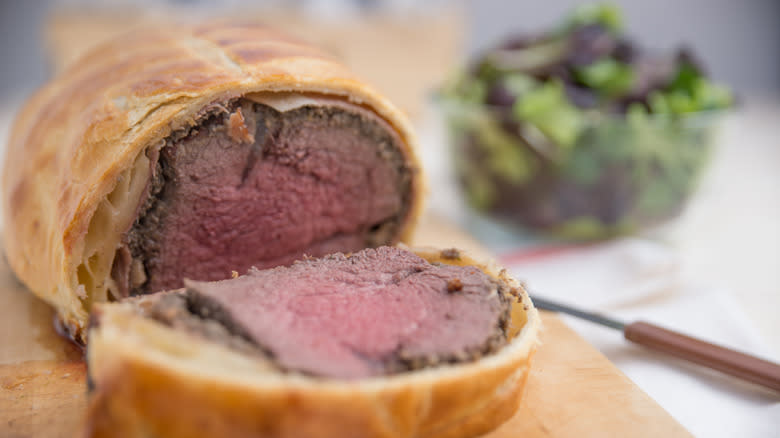The Reason Your Beef Wellington Crust Got So Soggy

With its layers of beef tenderloin, mushroom duxelles, prosciutto, and flaky puff pastry, beef Wellington is full of satisfying flavors and textures that make it a culinary delight. Mastering how to make one, however, can be challenging. With so many steps involved, there's a lot of room for error when making a beef Wellington. The most common mishap is the beef on the inside turning out undercooked while the puff pastry is flaky and golden. If you pre-cook your beef, use a meat thermometer, and set the oven to the right temperature, you might assume you're in the clear for a perfect result. But there's something else that can ruin a beef Wellington: A crust that's soggy on the bottom.
A mushy, uncooked puff pastry casing instead of a flaky golden one is a telltale sign that there was too much moisture trapped inside. This moisture typically comes from a combination of the juices that seep out of the tenderloin as it cooks and using mushrooms that are too watery. Excess moisture doesn't make the beef extra juicy. Instead, it prevents the puff pastry from fully crisping up, ultimately causing the crust to get soggy. Luckily, using proper cooking techniques can prevent too much moisture from collecting in your beef Wellington.
Read more: 15 Tips For Making The Best Meatloaf
How To Prevent A Soggy Beef Wellington

When pre-cooking the beef tenderloin for a beef Wellington, making sure to sear it and not just brown it is a crucial step in preventing sogginess. Searing locks in some of the juices so they don't seep out and pool in the bottom of the pastry.
The way you prepare the mushrooms for the duxelles is also key. Mushrooms hold a lot of moisture, and to prevent that moisture from ruining your beef Wellington crust, you will want to cook them until all the moisture evaporates. This doesn't happen over low heat, so it's best to stick to medium-high or high. Fortunately, mushrooms are almost impossible to overcook. After the mushrooms look dry enough, it also helps to pat them dry with a paper towel. Also, chilling them -- and the meat -- after cooking will prevent any excess steam from building up during the wrapping process.
These steps alone, however, are sometimes not enough. How tightly you wrap the puff pastry around the beef tenderloin also makes a difference. If it were too loose, it would create more room for moisture retention, even if you were to poke it with steam ventilation holes. It helps to refrigerate the pastry-wrapped tenderloin as well. This will stop the meat from overcooking and enhance the puff pastry's ability to crisp up during baking.
Consider Crepes In Your Beef Wellington Crust

If you're still worried about your beef Wellington turning out soggy, or if you want the crust to be extra crispy, take it from Gordon Ramsay and incorporate crepes in your recipe. Instead of the final layer before the pastry being prosciutto, the celebrity chef wraps his beef in an extra layer of crepes, creating another barrier from the moisture of the meat and duxelles. Ramsay also seasons his with thyme and chives to add another layer of flavor.
Nigella Lawson proposes a different though equally effective solution involving par-baking an extra layer of puff pastry and putting it at the bottom to absorb any stray juices. Keep in mind that adding more puff pastry and crepes may throw off the balance of meat to dough, so for a less bready option, you can opt for a thin sheet of phyllo dough instead, or even brush the bottom inside of the pastry with egg whites to effectively seal off the dough from moisture. If you combine this with properly cooked duxelles and seared beef tenderloin, the crust of your beef Wellington will turn out perfect every time.
Read the original article on Daily Meal.

